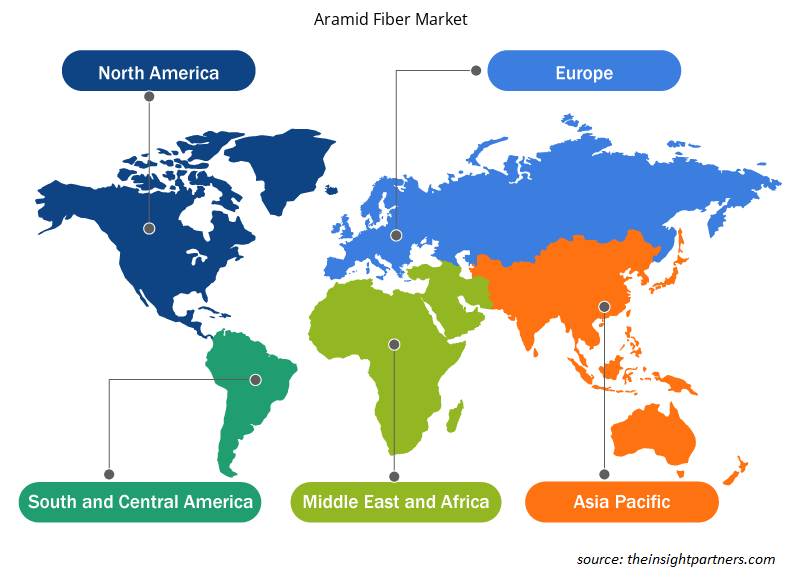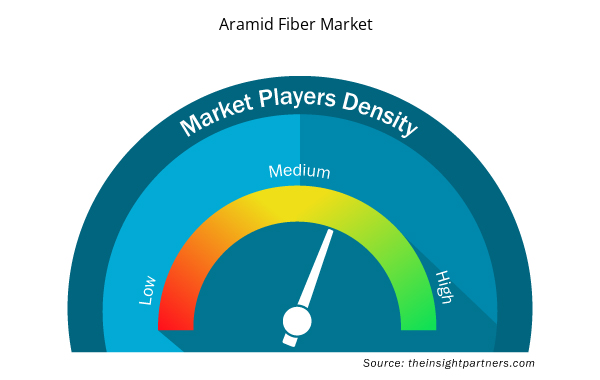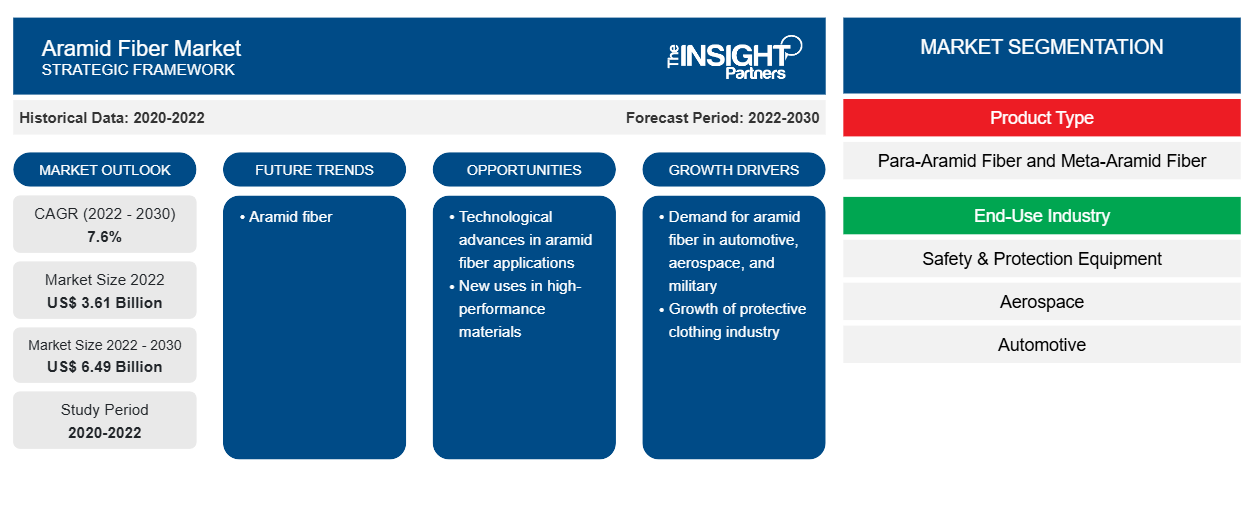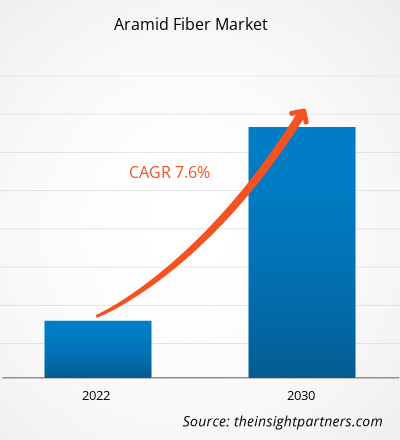[研究报告] 2022年芳纶纤维市场规模价值36.1亿美元,预计到2030年将达到64.9亿美元;预计2022年至2030年的复合年增长率为7.6%。
市场洞察和分析师观点:
芳纶纤维,又称芳香族聚酰胺,是一种具有优异强度、耐热性和耐用性的合成纤维。它们以高抗拉强度而闻名,抗拉强度是钢的五到六倍,重量轻,仅为钢的五分之一。这些卓越的性能使这些纤维具有广泛的应用价值,特别是在要求高性能和安全性的行业。芳纶纤维的独特结构对其优异的性能贡献巨大。这些纤维由长链聚酰胺分子组成,其中酰胺键直接与芳香环相连。这种排列产生了一种刚性的棒状结构,赋予纤维非凡的强度和刚度。此外,芳香环具有固有的耐热性和稳定性,使这些纤维能够承受高温而不会发生明显降解。
增长动力和挑战:
汽车行业不断增长的需求是芳族聚酰胺纤维市场扩张的主要驱动力。随着汽车制造商越来越注重生产更轻、更省油的汽车,对这些纤维的需求呈指数级增长。这些纤维,特别是对位芳族聚酰胺变体(包括 Kevlar)的高强度重量比允许开发轻量化部件而不损害结构完整性。在汽车领域,这些纤维广泛用于各种应用,包括制造轮胎、刹车、刹车片和复合材料。用这些纤维加固这些部件可提高其耐用性和耐磨性,有助于延长使用寿命并提高整体性能。此外,这些纤维用于生产汽车复合材料,提供强度和重量之间的平衡,这对于实现燃油效率目标至关重要。因此,所有这些因素都在推动汽车行业对芳族聚酰胺纤维的需求。
然而,芳族聚酰胺纤维市场的增长受到限制,因为具有类似或替代特性的替代品层出不穷。碳纤维是这些纤维的主要替代品之一,它与芳族聚酰胺纤维具有一些共同的特性,包括高强度和轻质特性。在某些应用中,制造商可能会选择碳纤维作为替代品,尤其是在寻求具有优异刚度或导电性的材料时。替代品的竞争对这些纤维的广泛采用构成了挑战,特别是在两种材料都可能满足所需规格的行业中。
定制此报告以满足您的需求
您可以免费定制任何报告,包括本报告的部分内容、国家级分析、Excel 数据包,以及为初创企业和大学提供优惠和折扣
- 获取此报告的关键市场趋势。这个免费样品将包括数据分析,从市场趋势到估计和预测。
报告细分和范围:
“2030 年全球芳纶纤维市场分析”是一项专业而深入的研究,主要关注全球市场趋势和增长机会。该报告旨在提供市场概况,并按产品类型和最终用途行业对市场进行详细细分。市场在最近一段时间内经历了高增长,预计在预测期内将继续保持这一趋势。该报告提供了全球芳纶纤维消费的关键统计数据。此外,该报告还对影响全球芳纶纤维市场表现的各种因素进行了定性评估。该报告还包括对市场主要参与者及其关键战略发展的全面分析。还包括对市场动态的几项分析,以帮助确定关键驱动因素、市场趋势和有利可图的机会,进而有助于确定主要收入来源。
生态系统分析和波特五力分析提供了对市场的360度视角,有助于了解整个供应链和影响全球芳纶纤维市场增长的各种因素。
节段分析:
根据产品类型,市场分为对位芳纶纤维和间位芳纶纤维。就最终用途行业而言,市场细分为安全与防护设备、航空航天、汽车、电子和电信等。安全与防护设备部门在 2022 年占据了芳纶纤维的很大市场份额。芳纶纤维,特别是对位芳纶变体(如 Kevlar),以其出色的强度、高模量和抗冲击性而闻名,使其成为安全和防护至关重要的应用的理想选择。这种纤维广泛用于制造防弹背心和头盔。这些纤维固有的防弹性,加上其重量轻的特性,使它们成为防弹衣的首选。世界各地的军事和执法机构广泛使用芳纶基防护装备,为人员提供有效的防弹威胁保护,同时不影响机动性。所有这些因素都在推动芳纶纤维市场在安全与防护设备领域的发展。
区域分析:
根据地理位置,芳纶纤维市场分为五个主要区域——北美、欧洲、亚太、南美和中美以及中东和非洲。市场以亚太地区为主,2022 年该地区的市场规模约为 10 亿美元。该地区为市场增长提供了大量机会。外国直接投资的增加也促进了该地区的经济增长。这些纤维在汽车零部件、电子产品等众多应用中的使用日益增多,预计将增加亚太地区对芳纶纤维的需求。
预计 2022 年至 2030 年期间欧洲的复合年增长率将超过 8.0%。芳纶纤维对于制造飞机结构和防弹系统中重量轻但坚固的部件至关重要。欧洲拥有领先的航空航天公司和重要的国防部门,这些行业对芳纶纤维的需求持续上升。此外,预计到 2030 年北美将达到约 17 亿美元。
行业发展和未来机遇:
以下列出了芳纶纤维市场主要参与者采取的各种举措:
- 2023 年 4 月,杜邦公司宣布推出 Kevlar EXOTM 芳纶纤维。Kevlar EXO 将提供芳纶纤维的轻便性、灵活性和防护性,生命防护是众多用例中的第一个。
芳纶纤维市场区域洞察
Insight Partners 的分析师已详尽解释了预测期内影响芳纶纤维市场的区域趋势和因素。本节还讨论了北美、欧洲、亚太地区、中东和非洲以及南美和中美洲的芳纶纤维市场细分和地理位置。

- 获取芳纶纤维市场的区域特定数据
芳纶纤维市场报告范围
| 报告属性 | 细节 |
|---|---|
| 2022 年市场规模 | 36.1亿美元 |
| 2030 年市场规模 | 64.9 亿美元 |
| 全球复合年增长率(2022 - 2030 年) | 7.6% |
| 史料 | 2020-2022 |
| 预测期 | 2022-2030 |
| 涵盖的领域 | 按产品类型
|
| 覆盖地区和国家 | 北美
|
| 市场领导者和主要公司简介 |
|
市场参与者密度:了解其对商业动态的影响
芳纶纤维市场正在快速增长,这得益于终端用户需求的不断增长,而这些需求又源于消费者偏好的不断变化、技术进步以及对产品优势的认识不断提高等因素。随着需求的增加,企业正在扩大其产品范围,进行创新以满足消费者的需求,并利用新兴趋势,从而进一步推动市场增长。
市场参与者密度是指在特定市场或行业内运营的企业或公司的分布情况。它表明在给定市场空间中,相对于其规模或总市场价值,有多少竞争对手(市场参与者)存在。
在芳纶纤维市场运营的主要公司有:
- 杜邦公司
- 帝人株式会社
- 烟台泰和新材料有限公司
- 晓星公司
- 东丽工业公司
免责声明:上面列出的公司没有按照任何特定顺序排列。

- 了解芳纶纤维市场顶级关键参与者概况
COVID-19 影响:
COVID-19 疫情对各国几乎所有行业都产生了不利影响。北美、欧洲、亚太地区 (APAC)、南美和中美以及中东和非洲 (MEA) 的封锁、旅行限制和企业停工阻碍了包括化学和材料行业在内的多个行业的增长。芳纶纤维公司制造部门的关闭扰乱了全球供应链、制造活动和交货计划。各公司报告称,2020 年产品交付延迟,产品销售下滑。疫情期间,大多数工业制造设施关闭,减少了这些纤维的消费量。此外,COVID-19 疫情导致芳纶纤维价格波动。然而,在供应限制得到解决后,各行业恢复了运营,从而导致塑料容器市场复苏。此外,汽车行业对这些纤维的需求不断增长,大大促进了芳纶纤维市场的增长。
竞争格局和重点公司:
杜邦公司、帝人株式会社、烟台泰和先进材料公司、晓星株式会社、东丽工业株式会社、可隆工业、汇维仕株式会社、中国蓝星(集团)有限公司、泰光工业株式会社和 Kermel SAS 是全球芳纶纤维市场的主要参与者。全球市场参与者专注于提供高质量的产品以满足客户需求。
- 历史分析(2 年)、基准年、预测(7 年)及复合年增长率
- PEST 和 SWOT 分析
- 市场规模价值/数量 - 全球、区域、国家
- 行业和竞争格局
- Excel 数据集



Report Coverage
Revenue forecast, Company Analysis, Industry landscape, Growth factors, and Trends

Segment Covered
This text is related
to segments covered.

Regional Scope
North America, Europe, Asia Pacific, Middle East & Africa, South & Central America

Country Scope
This text is related
to country scope.
常见问题
In 2022, Asia Pacific held the largest share of the global aramid fiber market. The region encompasses an ample number of opportunities for the growth of the market. Rising foreign direct investments also lead to economic growth in the region. The growing use of these fibers in numerous applications, including automotive parts, electronics, and others. All these factors led to the dominance of the Asia Pacific region in 2022.
A few players operating in the global aramid fiber market include DuPont de Nemours Inc, Teijin Limited, Yantai Tayho Advanced Materials Company, Hyosung Corporation, Toray Industries Inc, Kolon Industries, Huvis Corporation, China National Bluestar (Group) Co Ltd, Taekwang Industrial Co Ltd, and Kermel SAS.
The para-aramid fiber segment held the largest share in the global aramid fiber market in 2022. Para-aramids have high tensile strength (the highest stress that a material can withstand) and modulus behavior (the tendency of a material to deform when force is applied). The dry-jet, wet-spinning method is used to make these fibers, which results in fiber with completely extended liquid crystal chains generated along the fiber axis and a high degree of crystallinity, which boosts the fiber's strength. Their increasing use in security and safety applications drives the demand for para-aramid fibers. It is used in protective clothing such as bulletproof vests, helmets, and vehicle armor due to its ultra-high strength and rigid and highly oriented molecular structure. Thus, growing demand from the product type sectors led to the dominance of the para-aramid fiber segment in 2022.
Due to their excellent strength-to-weight ratio and heat resistance properties, aramid fibers play an essential role in composite materials and automotive and military applications. They can easily be integrated into textile applications in protective clothing, offer greater protection against heat, flame, and chemical products, and provide maximum comfort and absolute reliability. These fibers are a class of strong synthetic fibers commonly used in ballistic-rated body armor fabrics and composites. This reinforced fiber is lightweight and has a tensile strength five times stronger than the same weight, with high heat resistance and low cutting capacity. Growing demand from these end-used industries is driving the demand for aramid fiber from 2022 to 2030.
The automotive segment held the largest share of the global aramid fiber market in 2022. Aramid fibers are extensively used as a substitute for fiberglass and steel due to their lightweight, high tensile strength, and superior corrosion resistance in automotive hose manufacturing. Manufacturers in the automotive industry are constantly looking to stay competitive by bringing innovative products to market. Safety aspects, excellent performance, and the need for sustainability pressurizes the automotive industry to develop high-quality products.
Aramid fibers, particularly para-aramid variants such as Kevlar, are renowned for their exceptional strength, high modulus, and resistance to impact, making them ideal for applications where safety and protection are paramount. This fiber is extensively used in the manufacturing of ballistic vests and helmets. The inherent ballistic resistance of these fibers, coupled with their lightweight nature, makes them a preferred choice for body armor. Military and law enforcement agencies worldwide widely use aramid-based protective gear to provide personnel with effective protection against ballistic threats without compromising mobility. All these factors are expected to drive the safety & protection equipment from 2022 to 2030.
Trends and growth analysis reports related to Chemicals and Materials : READ MORE..
The List of Companies - Aramid Fiber Market
- DuPont de Nemours Inc
- Teijin Limited
- Yantai Tayho Advanced Materials Company
- Hyosung Corporation
- Toray Industries Inc
- Kolon Industries
- Huvis Corporation
- China National Bluestar (Group) Co Ltd
- Taekwang Industrial Co Ltd
- Kermel SAS
The Insight Partners performs research in 4 major stages: Data Collection & Secondary Research, Primary Research, Data Analysis and Data Triangulation & Final Review.
- Data Collection and Secondary Research:
As a market research and consulting firm operating from a decade, we have published and advised several client across the globe. First step for any study will start with an assessment of currently available data and insights from existing reports. Further, historical and current market information is collected from Investor Presentations, Annual Reports, SEC Filings, etc., and other information related to company’s performance and market positioning are gathered from Paid Databases (Factiva, Hoovers, and Reuters) and various other publications available in public domain.
Several associations trade associates, technical forums, institutes, societies and organization are accessed to gain technical as well as market related insights through their publications such as research papers, blogs and press releases related to the studies are referred to get cues about the market. Further, white papers, journals, magazines, and other news articles published in last 3 years are scrutinized and analyzed to understand the current market trends.
- Primary Research:
The primarily interview analysis comprise of data obtained from industry participants interview and answers to survey questions gathered by in-house primary team.
For primary research, interviews are conducted with industry experts/CEOs/Marketing Managers/VPs/Subject Matter Experts from both demand and supply side to get a 360-degree view of the market. The primary team conducts several interviews based on the complexity of the markets to understand the various market trends and dynamics which makes research more credible and precise.
A typical research interview fulfils the following functions:
- Provides first-hand information on the market size, market trends, growth trends, competitive landscape, and outlook
- Validates and strengthens in-house secondary research findings
- Develops the analysis team’s expertise and market understanding
Primary research involves email interactions and telephone interviews for each market, category, segment, and sub-segment across geographies. The participants who typically take part in such a process include, but are not limited to:
- Industry participants: VPs, business development managers, market intelligence managers and national sales managers
- Outside experts: Valuation experts, research analysts and key opinion leaders specializing in the electronics and semiconductor industry.
Below is the breakup of our primary respondents by company, designation, and region:

Once we receive the confirmation from primary research sources or primary respondents, we finalize the base year market estimation and forecast the data as per the macroeconomic and microeconomic factors assessed during data collection.
- Data Analysis:
Once data is validated through both secondary as well as primary respondents, we finalize the market estimations by hypothesis formulation and factor analysis at regional and country level.
- Macro-Economic Factor Analysis:
We analyse macroeconomic indicators such the gross domestic product (GDP), increase in the demand for goods and services across industries, technological advancement, regional economic growth, governmental policies, the influence of COVID-19, PEST analysis, and other aspects. This analysis aids in setting benchmarks for various nations/regions and approximating market splits. Additionally, the general trend of the aforementioned components aid in determining the market's development possibilities.
- Country Level Data:
Various factors that are especially aligned to the country are taken into account to determine the market size for a certain area and country, including the presence of vendors, such as headquarters and offices, the country's GDP, demand patterns, and industry growth. To comprehend the market dynamics for the nation, a number of growth variables, inhibitors, application areas, and current market trends are researched. The aforementioned elements aid in determining the country's overall market's growth potential.
- Company Profile:
The “Table of Contents” is formulated by listing and analyzing more than 25 - 30 companies operating in the market ecosystem across geographies. However, we profile only 10 companies as a standard practice in our syndicate reports. These 10 companies comprise leading, emerging, and regional players. Nonetheless, our analysis is not restricted to the 10 listed companies, we also analyze other companies present in the market to develop a holistic view and understand the prevailing trends. The “Company Profiles” section in the report covers key facts, business description, products & services, financial information, SWOT analysis, and key developments. The financial information presented is extracted from the annual reports and official documents of the publicly listed companies. Upon collecting the information for the sections of respective companies, we verify them via various primary sources and then compile the data in respective company profiles. The company level information helps us in deriving the base number as well as in forecasting the market size.
- Developing Base Number:
Aggregation of sales statistics (2020-2022) and macro-economic factor, and other secondary and primary research insights are utilized to arrive at base number and related market shares for 2022. The data gaps are identified in this step and relevant market data is analyzed, collected from paid primary interviews or databases. On finalizing the base year market size, forecasts are developed on the basis of macro-economic, industry and market growth factors and company level analysis.
- Data Triangulation and Final Review:
The market findings and base year market size calculations are validated from supply as well as demand side. Demand side validations are based on macro-economic factor analysis and benchmarks for respective regions and countries. In case of supply side validations, revenues of major companies are estimated (in case not available) based on industry benchmark, approximate number of employees, product portfolio, and primary interviews revenues are gathered. Further revenue from target product/service segment is assessed to avoid overshooting of market statistics. In case of heavy deviations between supply and demand side values, all thes steps are repeated to achieve synchronization.
We follow an iterative model, wherein we share our research findings with Subject Matter Experts (SME’s) and Key Opinion Leaders (KOLs) until consensus view of the market is not formulated – this model negates any drastic deviation in the opinions of experts. Only validated and universally acceptable research findings are quoted in our reports.
We have important check points that we use to validate our research findings – which we call – data triangulation, where we validate the information, we generate from secondary sources with primary interviews and then we re-validate with our internal data bases and Subject matter experts. This comprehensive model enables us to deliver high quality, reliable data in shortest possible time.


 获取此报告的免费样本
获取此报告的免费样本